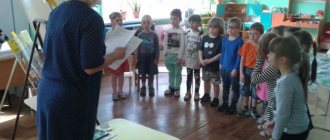Game description
Children are divided into 2 subgroups and placed perpendicular to each other. The first is steam locomotives, the second is cars. When the traffic light turns green, the “Locomotives” start moving and the “Cars” stop. At a red traffic light
The "Locomotives" stop and the "Cars" begin to move.
“Steam Locomotives” and “Cars” start moving when the traffic light turns green.
“Locomotives” and “Cars” stop at a red traffic light.
No. 6. “THE CHILDREN GO TO GARDEN”
Target:
Exercise children in running in a straight line at the teacher’s signal. Reinforce knowledge of traffic lights.
Game description
Children, at the teacher’s signal, follow each other without bumping into each other. Couples stop at a red traffic light. When it turns green, they continue driving.
Rules:
Couples start moving when the traffic light turns green.
Couples stop at a red traffic light.
Game description
Children line up in a column along one side of the playground or along the wall of the room. The first one standing in the column is a “locomotive”, the rest are “cars”.
The teacher blows the horn and the children begin to move forward (without clutch); at first slowly, then faster and start running (when moving slowly, children can pronounce the sounds “chu-chu-chu”).
“The train is approaching the station,” says the teacher. Children gradually slow down and stop.
The teacher blows the whistle again, and the train moves again. The total duration of the game is 4-5 minutes.
No. 4. “SPARROWS AND THE CAR”
Target:
Exercise children in running in different directions, without bumping into each other, in the ability to start a movement and change it at the teacher’s signal, to find their place
Game description
When the image of a sparrow is raised, the “Sparrows” begin to move; when the image of a car is raised, the “Cars” begin to move. Children run around the playground, trying not to disturb each other. The team that doesn't make a single mistake wins.
Rules:
The game begins at the teacher's signal.
When the image of a sparrow is raised, the sparrow children move.
When the image of a car is raised, children-cars move.
Didactic games on traffic rules in the senior group
Didactic games on traffic rules for older preschoolers according to the Federal State Educational Standard
Game “Assemble a sign”
Objectives: to consolidate children’s knowledge about road signs and traffic rules; develop logical thinking, attentiveness; foster a culture of safe behavior on the road and in public places. Material: envelopes contain puzzles - road signs, chips. Progress of the game. Children are divided into crews (teams), at the teacher’s signal, they open envelopes and put together their signs from the parts.
To complete the task - 5 minutes. For a correctly assembled sign - 1 point. Extra points can be earned if players correctly answer the name of the sign and what its meaning is. Game “Cross the Road”
Purpose : to consolidate children’s knowledge about traffic lights. Progress of the game. The teacher alternately raises three circles: red, yellow, green. Children must cross the intended “road” (carpet path, passage marked with ribbons, pebbles, etc.). Children who cross the “road” into a red or yellow circle leave the game.
Game “Green Eye”
Purpose : to consolidate children’s knowledge about traffic lights. Progress of the game. A mock-up traffic light is installed at the entrance to the kindergarten.
When the children return after a walk, the teacher “turns on” the red light - “You can’t go”, then the yellow light - “Get ready.” You are only allowed to enter the premises when the light is green. Game “Our Street”
Purpose : to teach children to distinguish between road signs (warning, prohibiting, prescriptive, informational) intended for drivers and pedestrians. Material: model of a street with houses, intersection; cars (toys); pedestrian dolls; driver dolls; traffic light (toy); road signs, trees (layouts). Progress of the game. The game is played on a layout.
With the help of dolls, children, on the instructions of the teacher, act out various road situations. Game “Turns”
Goal : to develop coordination of hand movements (right, left), visual attention. Material: signs: “Move straight”, “Move right”, “Move left”; rudders. Progress of the game. If the teacher shows the sign “Move straight,” then the children take one step forward; if the sign is “Move right,” they turn to the right by moving the “steering wheel,” and if the sign “Move to the left,” they turn left by moving the “steering wheel.”
The one who makes a mistake leaves the line. Game “Crossroads”
Purpose: to consolidate children’s knowledge about traffic lights. Progress of the game. Four presenters, two of whom receive red circles, the other two - green, stand at the “crossroads”.
Children pretend to be pedestrians and cars. When the whistle blows, the presenters raise their respective mugs, and the “pedestrians” and “cars” begin to move. The next whistle indicates a change of traffic light signal, the drivers change places. "Pedestrians" and "cars" stop. After the next whistle, the movement resumes, and the offenders leave the game. Game “Guess the Transport”
Goals: to consolidate children’s ideas about transport, the ability to find objects by description; develop ingenuity, quick thinking and speech activity. Material: pictures (cards) depicting transport. Progress of the game. The teacher asks the children riddles about types of transport.
The child who guesses what kind of transport is being discussed in the riddle receives a picture with its image. Whoever has the most pictures at the end of the game is the winner. Game “Find a Safe Way”
Objectives: to reinforce the rules of the road and behavior on the road; develop thinking, memory, attention; Expand words knowledge. Material: model of a street (road part), road signs, traffic lights, transport (passenger cars, trucks), pedestrian dolls. Progress of the game. Children, on the instructions of the teacher, act out various situations on the model that promote safe movement along the streets.
Riddles about road signs
What a miracle this is. Two humps like a camel? This sign is triangular, what is it called? (Rough road.) This sign warns that the road here has a zigzag and a steep one awaits the car ahead... (dangerous turn). A striped horse, they call it “zebra”. But not the one at the zoo... People walk along it here. (Transition.) Where the steps lead down, Go down, don’t be lazy. The pedestrian must know: Here... (underground passage).
We recommend watching:
Quest is a traffic rules game for the older group. Abstract Scenario of a game program on traffic rules for children of senior preschool age Interactive game on traffic rules for children 5-7 years old Lapbook on traffic rules for children of senior preschool age
Similar articles:
Games on traffic rules for the senior group of preschool educational institutions
Description: This material will help the teacher organize work with children 2-3 years old and their parents to develop basic knowledge of road safety rules. Didactic game “Which light came on” Objectives: consolidate knowledge of traffic light colors. Equipment : “Live picture” - a street, a picture of a traffic light with round holes, circles in red, yellow and green. Contents of the game. The teacher alternately inserts circles of different colors into the traffic light holes in the “Live Picture” and invites the children to name these colors and explain what they mean for pedestrians. Didactic game “What does the traffic light say?” Objectives: to form children’s elementary ideas about the meaning of the colors of the traffic light and the rules of the road. Equipment: “Live picture” - street, pictures: traffic lights, cars for various purposes; road markings, figures of people. Contents of the game. The teacher prepares a model of the road with pedestrian crossing markings, creates various traffic situations using human figures, and invites the children to show the correct behavior of pedestrians and drivers on the road. Didactic game “What’s missing” Objectives: consolidate knowledge about car parts. Equipment: pictures of cars, car parts. Contents of the game. The teacher shows the car, clarifies what is missing, then offers to find a picture with the missing part. Didactic game “Our Street” Objectives: to form children’s elementary ideas about the concepts: street, road, sidewalk, trees, houses; basic understanding of the rules of behavior on the road. Equipment: “Live picture” - a street, a picture of a traffic light with holes, circles of red, yellow and green colors, figures of children, pictures of cars, road signs. Contents of the game. The teacher shows the children a picture and tells them that when crossing the road, they should not rush, they must be careful, they must not play near the road, cross the road at a pedestrian crossing, distinguish between traffic lights (green - you can go, red - no movement), road signs . Didactic game “What do we drive?” Objectives: to teach children to recognize and show vehicles by ear. Equipment: pictures of vehicles. Contents of the game. The teacher reads a poem to the children, then asks what it says and asks the child to find a picture of this vehicle. The steam locomotive The locomotive hummed and the carriages were carried away. Chu-choo, choo-choo! I'll take you far! (T. Volgina) Truck No, in vain we decided to Ride the cat in the car: The cat is not used to riding - He overturned the truck. (A. Barto) Airplane We’ll build the airplane ourselves, Let’s fly over the forests. Let's fly over the forests, and then return to mom. (A. Barto) Helicopter Helicopter, helicopter! Take me on a flight! And in flight it’s empty, cabbage has grown! (teaser) Ship Sailor cap, rope in hand. I’m taking a boat along a fast river, and the frogs are jumping on my heels, and they ask me: “Give me a ride, captain!” (A. Barto) Didactic game “What do we drive?” Objectives: to teach children to recognize familiar vehicles, to designate them in words. Equipment: “Live picture” - street, pictures of vehicles. Contents of the game. The teacher one by one inserts pictures of vehicles into the holes in the “Live Picture” and asks what is drawn on it. Children answer on their own or with the help of a teacher. Then the teacher offers to look at the picture and notes what color the machine is, what it is needed for, and together with the children names its parts, etc. Didactic game “Let me tell you something” Tasks: Fix the name of the transport, activate the dictionary. Equipment: toys bus, truck, car, plane, boat. Contents of the game. Toys are on the table or carpet. The child is at a distance of 1-2 meters from the table. The teacher asks the child: “Bring a bus (plane, truck, etc.).” If the child finds it difficult, the teacher clarifies: “It is red, standing near the plane,” or simply points to the desired toy. Then he asks questions, specifying what the child brought, what color the bus is, its size; look at its parts. Didactic game “Wonderful Bag” Objectives: Clarify and activate the vocabulary on the topic “Transport”. Equipment: Toys: bus, truck, car, airplane, boat, bag. Contents of the game. The teacher takes the cars out of the bag one by one. Together with the child, he examines and discusses their appearance (truck, bus, etc.), color, material, purpose. Specifies the name of the parts, their color and shape.
Didactic game “Running traffic light”.
Children follow the leader. From time to time the presenter raises the flag, then turns around. If the green flag is raised, the children continue to move behind the leader; if the flag is yellow, they jump in place; if the flag is red, everyone must “freeze in place” and not move for 15-20 seconds. Whoever makes a mistake leaves the game. The most attentive one wins.
Didactic game "Traffic Light".
Two teams of 5 to 7 people line up in a semicircle, one to the left, the other to the right of the teacher.
In the hands of the teacher there is a traffic light - two cardboard circles, one side of which is yellow, the other side of the circles is different (red or green).
The teacher reminds the children how important it is to follow the traffic rules on the street, cross it only in designated places where the sign “crossing” is written, first look to the left to make sure that there is no car nearby, and where there is a traffic light, carefully monitor it . The teacher reads poems by S. Mikhalkov to the children.
The guys suggest the missing words in unison.
If the light turns red, then move... (dangerous).
The green light says: “Come on, the way is (open).”
Yellow light - warning - Wait for the signal to....(move).
Then the teacher explains the rules of the game:
— When I show a green traffic light, everyone marches in place (you have to start with the left foot, when it’s yellow, they clap their hands, and when it’s red, they stand still.
Anyone who mixed up the signal takes a step back.
Signals should change unexpectedly, at different intervals. The team that has the most participants left at the end of the game wins.
Didactic game “We are young motorists.”
The teacher, having checked the children’s knowledge of traffic rules, hands each of them a driver’s license. Having received a driver's license, children of senior and preparatory groups move around the playground, observing the rules of the road: Stick to right-hand traffic.
• Respond correctly to traffic lights.
• Let pedestrians pass (children of the younger group with a teacher).
.
Didactic game "Stop".
At a distance of 10-16 steps from the boundary of the court, a line is drawn (the original one, on which the players stand close to each other. At the opposite end of the court, the place of the driver is outlined in a circle (with a diameter of 2-3 steps).
Turning his back to the players, the driver says loudly:
“Walk quickly, don’t yawn! Stop!"
At these words, all the players move towards the driver. As soon as the driver says the word “stop!”, everyone stops, the driver quickly looks around.
The one who did not manage to stop in time after the word “stop!” and made an additional movement, the driver returns to the starting line.
Then he again turns his back to the players and says:
"Walk quickly." etc.
Everyone continues moving from the place where they were caught by the “stop!” signal.
Those who returned to the starting line begin moving from there. This continues until one of the players comes close to the driver and stands in a circle before the driver says “stop!” The one who managed to do this becomes the driver.
The game resumes with a new driver.
Didactic game “Skillful Pedestrian”.
Option 1. At a distance of 60 cm, 5 m of cord are placed parallel to each other. You have to walk blindfolded along the path between them. Option 2. Two circles are made from two cords - outer and inner. The distance between them is 1 m. You need to walk in a circle between the cords blindfolded.




